Connecting Natural Abilities
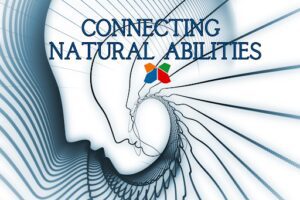
What we know from the scientific study of human engineering is that we are all born with innate abilities. What we have learned from decades of practical application is that understanding the interplay between these abilities or how they synergistically contribute to our overall potential will provide valuable insights that will enhance our journey of self-discovery.
For over three decades, the Highlands Company has assessed and evaluated human aptitudes for tens of thousands of students and adults in the pursuit of our mission to help people discover their natural gifts and talents and work where they can use them. It is known that when individuals focus on their natural abilities when constructing a strategic plan for life and career, they experience profound and lasting benefits: reduced stress, greater overall balance, decreased burnout, and increased satisfaction.
Through our extensive experience in aptitude testing and research into what makes people successful, we have recognized the significance of connecting abilities, putting them into context, and understanding what aptitudes are and what they are not, preventing any misconceptions or misinterpretations. By doing so, we empower individuals with powerful insights, enabling them to harness their unique talents effectively and chart a path toward personal and professional fulfillment.
Assessing Aptitudes
The foundation of the Highlands Aptitude Testing program is the Highlands Ability Battery (HAB), a research-based tool developed to assess a number of cognitive aptitudes. Based on science, not self-report, the HAB separates aptitudes from learned skills through objective, timed worksamples or performance-based activities completed online within a set amount of time.
For an inventory and description of each of the individual abilities measured by the HAB link here-
Your Natural Abilities: What the Research Reveals and How They are Measured - The Highlands Company
Understanding Natural Abilities vs Skills
Aptitudes and skills are distinct concepts that describe different aspects of an individual’s performance. Aptitudes are innate abilities that individuals often possess from birth or develop early on, while skills are acquired through external influences and can be honed through deliberate practice, learning, and experience. Aptitudes tend to endure over time, while skills will decline with disuse.
Many people assume their “performance” represents their aptitudes; it is what the outside world sees and evaluates. In reality, “performance” is a combination of abilities and skills. And, while the outside world understandably focuses on (and pays for) “performance”, individuals can lose sight of what needs expression, the contributions for which they want to be valued, and how their natural abilities contribute to their satisfaction, contentment, and happiness over the long-term.
Considering Aptitudes in Context
The results of the HAB provide a person insight into how their mind works naturally or what takes less time/effort/energy as well as what takes more time/effort/energy, which is the difference between an aptitude and an acquired skill. However, it does not reflect the effort or choices a person has made, will make, or should make.
Recognizing that human beings are more complicated than aptitudes, skills, and even interests alone, Highlands has developed the Personal Vision Coaching Program, a full-range comprehensive coaching program to enable the consideration of additional dimensions that make up the person as a whole and ultimately influence performance. Developing a clear vision for the future, one that embraces your strengths, values, and aspirations, must also include personal style, family influences, values, goals, and adult /career development.
Instead of simply asking yourself, “What am I good at?”, understanding the (context) conditions within which you are “good at” something is critical to making the best decisions. Blending that understanding with reflective intention using the Highlands Whole Person Model and Methodology creates a consistent path toward best-fit choices.
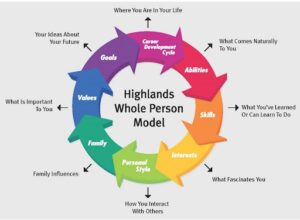
To learn more about the Highlands Personal Vision Coaching Program and Whole Person Methodology, click here- How to Create Your Own Personal Vision to Guide Your Life (highlandsco.com)
While it is impossible to cover all of the factors in the Highlands Whole Person Model for the purpose of this article, exploring the interplay between aptitudes alone can provide interesting influences.
Connecting Aptitudes for Real-Life Implications
Research has consistently demonstrated that aptitudes don’t operate in isolation. Like puzzle pieces, individual aptitudes hold limited value on their own; it is only by comprehending how these pieces harmoniously fit together that we can truly grasp their significance for each individual.
Drawing on over thirty years of experience in evaluating aptitudes, the Highlands Company has identified combinations of abilities in our proprietary ability blends and ability patterns that shed light on your innate style of communication, problem-solving, and information assimilation. By uncovering these interconnected abilities, you gain valuable insights not only into the most suitable career paths but also into the specific roles, responsibilities, and work environments within various occupations where you are likely to thrive.
We’ll share some examples of the ability patterns here for Personal Style, Driving/Reasoning Abilities, and Spatial Reasoning combinations with practical implications for Students and Adults. See if any of the combinations of aptitudes resonate with you.
To begin your journey of self-discovery through the Highlands Aptitude Testing program, contact the Highlands Company or connect with a Highlands Certified Consultant today.
Highlands Ability Patterns - Examples
Highlands Ability Patterns, Stiles, D., Ph.D. Highlands Career Exploration Supplement. Copyright 2023, The Highlands Company. All rights reserved.
Author, Dori Stiles, PhD. Industrial Organizational Psychology, Director of Training, Research and Development for The Highlands Company, publisher of the Highlands Ability Battery (HAB).
 Ability Pattern-Example 1
Ability Pattern-Example 1
The Abilities (Advising)
Mid-to-high Specialist + High Classification and
Concept Organization with Low Spatial Visualization
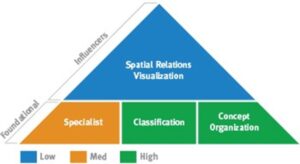
How They Work Together
This pattern combines a Specialist orientation with a Consultative problem-solving style (high Classification and Concept Organization) in the intangible world (lower Spatial Relations Visualization). People with this pattern have a way of reasoning their way through life. The hallmark of this pattern is making connections rapidly and organizing information easily. This Consultative problem-solving style combines the ability to diagnose what is wrong and prescribe solutions to fix it. People with this pattern are able to gather and understand a range of unrelated information, organize it, and present it in a factual and convincing manner. The ability to quickly identify problems, logically look at each step in the process, and then communicate findings in an articulate fashion allows them to work most effectively in a career that demands fast pace and rapid-fire problem-solving.
Work Role Considerations
Advising has many varied applications. You could be a doctor advising a patient on treatment or care, a lawyer advising a client on a contract, a financial planner advising a client on an investment strategy, a human resources manager advising an employer on an applicant to hire, or a marketing manager advising the company on what advertising strategies should be used. You have the natural ability to combine various components into a case or a pattern and to analyze causes. This is a highly valued skill in almost any industry.
With lower Spatial Relations Visualization, people with this pattern lean toward thinking intangibly, are comfortable dealing with laws, theories, concepts, and ideas, and do not require a tangible or concrete outcome of their work to feel satisfied. If you have a medium to high Spatial Relations Theory score, you may be especially good at working with intangible systems such as those used in Human Resources or Organizational Psychology.
Career Considerations
Link here for Occupations to Explore.
 Ability Pattern- Example 2
Ability Pattern- Example 2
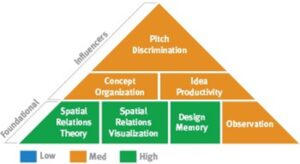
The Abilities (Engineering - Technical Design)
High Spatial Theory, Spatial Visualization, Design
Memory + Mid-to-high Observation with
Mid-to-high Concept Organization, Idea Productivity, and Pitch Discrimination
How They Work Together
This pattern combines an Analytical problem-solving style (mid-to-high Concept Organization) with Spatial abilities (high Spatial Theory and Visualization), heightened sensory awareness (mid-to-high Pitch Discrimination), and powerful Visual abilities (high Design Memory, mid-to-high Observation). Concept Organization, the most fundamental ability required for science and research, plays a prominent role in this pattern; it helps in the communication of ideas to others in papers or books. This unique combination of relative strength in Design, Observation, Idea Productivity, as well as Pitch Discrimination really points to a specialization in the design sector of engineering or technical design or the visual careers in medicine like radiology or biomedical engineering.
Work Role Considerations
In order to be successful in using this ability pattern, it is important to develop an area of technical or design expertise. The most efficient way to do this is through school, formalized training, or specialized training. Sometimes, instead of heading down a traditional engineering route, people with this ability pattern will choose engineering technologies, which tend to be more hands-on and concrete in their applications.
Use your interests to guide you. Some people with this ability pattern are drawn to very concrete, tangible work. Others are interested in the intangible, such as why people use a product in a certain way. Being able to articulate what you like to think about will help you settle into a career that will bring you the most satisfaction.
Career Considerations
Link here for Occupations to Explore.
 Ability Pattern- Example 3
Ability Pattern- Example 3
The Abilities (Specializing - Connecting/Helping People)
Mid-to-high Specialist + Low Classification,
Concept
Organization and Spatial Visualization with Mid-to-high
Tonal Memory, Observation, and Extroversion
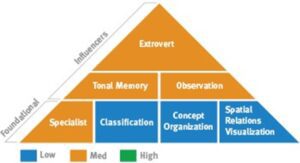
How They Work Together
This pattern combines the Detailed Communicator Personal Style (Extroverted Specialist) with Pragmatic Problem Solving (lower Classification and Concept Organization), comfort with working with intangibles (lower Spatial Visualization), and attentiveness to what is seen and heard (mid-to-high Observation, Tonal Memory). Naturally driven to understand specific areas of interest in great detail, they are patient and less likely to jump to conclusions when faced with new situations. In addition, people with this pattern have a natural comfort working in the intangible world of ideas, relationships, and thoughts.
Specialists are most comfortable when they develop a specific area of expertise and deliver services from the perspective of an expert or specialist in the field. Observation enables people with this pattern to notice changes in people’s faces, expressions, and moods, and Tonal Memory indicates an ability to listen and focus on people as they speak. As a Pragmatic Problem Solver, you are able to draw on your own experiences as well as those of others to build a powerful database of information, solutions, and positive outcomes. Mastering a set of skills first will provide you with experiences from which you will select your solutions.
Work Role Considerations
Once you develop an area of competence and experience, you will be capable of moving to influential positions in almost any industry. As long as you stay in your chosen field and learn from your experiences, you can become the quickest problem solver in the organization because you are able to cut through the distractions of too much information and get right to the point. Being conscious of your preference for Introversion or Extroversion will help you evaluate careers where interaction with people is almost constant or careers with a combination of interaction and solitary time. These interactive careers would be more taxing for you if you are more in the mid-range on the Introvert/Extrovert scale. Seeking a career with a combination of interaction and solitary time might be more satisfying for you.
You benefit from getting to know people and enjoy building on those relationships. You work well in the intangible world and are comfortable dealing with emotions, ideas, theories, feelings, and relationships. This powerful pattern makes you well-equipped to concentrate and focus on the problems that are presented to you. You have an understanding of the people involved and will patiently work towards the best outcome for all.
The direction for this pattern is related to your unique interests. Before you review the suggested careers below, click this link: https://www.mynextmove.org/explore/ip to explore your interests on ONET's free, 10-minute Interest Profiler.
Career Considerations
Link here for Occupations to Explore.
 Ability Pattern- Example 4
Ability Pattern- Example 4
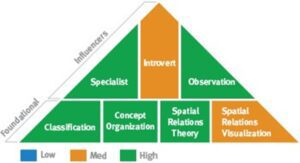
The Abilities (Specializing - Life Science)
High Classification, Concept Organization,
and Spatial Theory + Mid-to-high Spatial Visualization with High
Observation and Specialist + Mid-to-high Introvert
How They Work Together
This pattern combines the Detailed Researcher's Personal Style (Specialist, mid-to-high Introvert), with convergent reasoning abilities (high Classification and Concept Organization), spatial abilities (Spatial Theory and mid-to-high Spatial Visualization), and the ability to notice visual details (high Observation). The foundation of this pattern is the ability to solve tangible problems by analyzing the available data and diagnosing the cause. Understanding the ways systems interact and the ability to see visual details gives those with this pattern an advantage in any life science career.
Specialists with these four driving abilities often have a unique way of looking at life. With the addition of Introversion, people with this pattern typically have a thirst for knowledge in their areas of interest and spend a good amount of time researching those topics on their own. The Specialist side brings focus in a specific field of study, and a preference for introversion brings comfort in scientific environments such as laboratory work and solitary field experiments.
Work Role Considerations
Life science specialists influence others with their depth of technical knowledge rather than their jovial, persuasive interaction. Typical of this ability pattern are the research scientists who spend their lives going deeper and deeper into an area of interest, which may or may not have a commercial application.
Career Considerations
Link here for Occupations to Explore.
 Ability Pattern- Example 5
Ability Pattern- Example 5
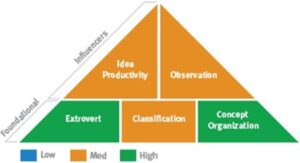
The Abilities (Instructing - Training)
High Extrovert and Concept Organization +Mid-to-high Classification with Mid-to-high
Idea Productivity and Observation
This pattern combines idea-rich (mid-to-high Idea Productivity), Consultative problem-solving (mid-to-high Classification and high Concept Organization) with attention to detail (mid-to-high Observation) and comfort with a lot of people interaction (high Extroversion). People with this combination have a natural talent for public speaking. They generate many ideas and then organize and articulate them in ways that are both logical and interesting.
Classification enables people with this pattern to react and respond to questions and comments on the spot, making connections where others see none. This high-level problem-solving makes them believable as presenters. It is important for people with this pattern to develop in-depth knowledge of the topics on which they speak in order to answer questions accurately and reliably. Without the depth, they may be tempted to “wing it”, and jeopardize their reputation as a reliable source. Concept Organization enables those with this pattern to keep ideas organized in their heads, and Extroversion enables them to be energized by the audience.
Work Role Considerations
The more interactive the situation is, the more energized people with this pattern will be. Although capable of presenting lectures, the gifts of this style will shine through when training interactively. Training and public speaking is enhanced with Observation. This allows people with this pattern to notice subtle changes in the facial expressions and body language of the audience and mid-course corrections when missing the mark. Whether applying this pattern to a full-time job, or utilizing it as a formal or informal work responsibility, this pattern will assert itself and be recognized by others.
Career Considerations
Link here for Occupations to Explore.
